
A spot for healing on Bright Angel Trail
GRAND CANYON VILLAGE, Ariz. — For almost 1,000 years, the Hopi Native Americans have called the Grand Canyon their home. The canyon is embedded in their culture as deeply as it is engraved in the sandstone of the Colorado Plateau.
According to Hopi lore, the Hopi’s ancestors fell into an era of irreverence. Frustrated, their god, Tawa, destroyed the “Third World,” while another deity, The Spider Mother, brought the worthy Hopi into the new, “Fourth World” through a great reed called sipapu. They believe the Grand Canyon was that sipapu.
| The author stretches during his hike down Bright Angel Trail into the Grand Canyon (Photos by Nick Sirio). | 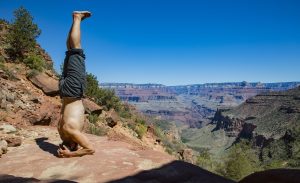 |
After being birthed in the canyon, the Hopi stayed in its territory. Traditionally, they migrated annually from the rim to the river of the canyon, following water, game, and gathering salt from the canyon’s stone. Their timeless paths have become engraved in the canyon and are still the trekking trails visitors use today.
Petroglyphs line the paths—directions, guides and spiritual sketches. The sheer rock sides of the canyon also amply echo, especially down the side shoots and canyons that branch from the main, Colorado River-ed ditch.
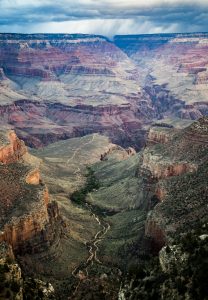 |
At left, Bright Angel Trail, thousands of feet below the rim, as it continues towards Plateau Point. Below, thunder clouds form over the North Rim of the canyon. |
Winding down from the South Rim on Bright Angel Trail, one of the best-maintained and easily-accessible trails in the park, you can hear the echoes of hikers rushing down the gorge like water. Singing birds come from one wall, then the other, fading away and down.
A clap sounds like a trotting horse. Airplanes occasionally pollute the soundscape and fill the vessel-like canyon with thunder. Thunder fills the canyon like a god—like the thunder god Native Americans believe lives here.
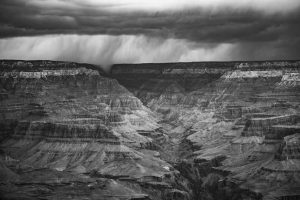 In such a sacred valley, it’s not hard to observe and harness the four elements (similar to the Greek four) that Natives believe essential for healing: earth, in the cathedraled pillars and walls of rock; air, in the blue tint of atmosphere that you can see filling the canyon like water in a giant fishbowl; the water that’s carved away the rock and still pumps like an artery through the bottom of it; and warmth from the desert sun, the same warmth that breathes into life to animate the other three elements.
In such a sacred valley, it’s not hard to observe and harness the four elements (similar to the Greek four) that Natives believe essential for healing: earth, in the cathedraled pillars and walls of rock; air, in the blue tint of atmosphere that you can see filling the canyon like water in a giant fishbowl; the water that’s carved away the rock and still pumps like an artery through the bottom of it; and warmth from the desert sun, the same warmth that breathes into life to animate the other three elements.
About an hour hike down Bright Angel Trail, there’s a corner in the trail at what is evidently a flash flood zone when it rains. Here, the water runs down the center of this side-canyon over two consecutive waterfalls have left flat platforms and an amphitheater-looking depression against the wall between. It’s a perfect spot to chill, rest and heal.
I was hobbling down the path on a strained hamstring, wondering if I should bother making it closer to the bottom, following the current of visitors seeing how close they could get to a glimpse of the Colorado at Plateau Point.
| A rest spot under a flash flood waterfall. | 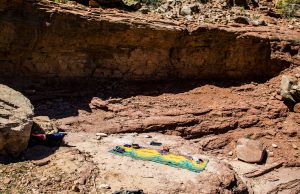 |
I saw this spot and made up my mind. I laid out my blanket as a yoga mat, pulled out my Tibetan singing bowl, a book, a box of raisins and spent the day fixing myself.
And it worked. On the way up the trail, I bounded barefoot and completely forgot about my hamstring. It seemed to me that if I’d only be visiting the canyon a couple days, there was no way I was going to get more than a superficial view, so hanging out a quarter of the way down felt more right. It felt more appropriate than sprinting for the bottom.
Instead, I tried to channel the canyon’s natural wonder into my messed up leg and my stressed out brain. I walked out of the trail in a much better way than I walked in …
For the someday when you’ll make it to the canyon (or for wherever you find your peaceful place closer to home) here’s a suggested Yin yoga practice that uses Bright Angel Trail for physical and mental healing via slow stretches for deep healing and a great inversion at the end for a unique view of this majestic canyon
STRETCH! Sunrise in the canyon is something spectacular as our star peaks over the east walls and laps the west walls like a happy puppy. As the sun comes up, try to warm and wake the body with a gentle bend from mountain pose. Get some blood into the quads and calves for the hike down.
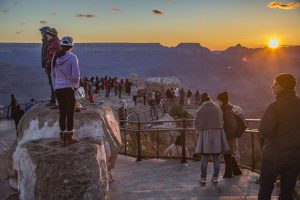 |
Early risers at Mather Point on the South Rim of the Grand Canyon are rewarded with a sunrise unlike any others in the world. |
On the way down:
Walk slowly and mindfully. Since this is a day-hike route, hopefully your pack isn’t too heavy, so drop your weight a little into your hips and bend your knees. Try to stay focused on every footfall and land quietly. The trail is generally soft and sandy and great for the knees. Keep an eye out for mule crap, but aside from that, look up and around and enjoy the sunlight as it continues to wash into the canyon.
As you switch back and forth, play with the echo. Let out Whoops! or Heys! or yells or Oms.
| At right, one of the views while hiking into the canyon along Bright Angel Trail. Below, a set up ready for a yoga session. | 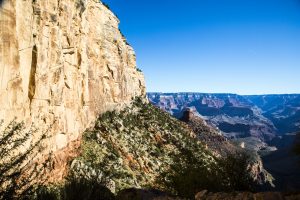 |
Stop at the mile-and-a-half resthouse if you’ve got to use the bathroom. This is your last stop before the dry waterfalls … and the closest toilet.
You’ll round a couple more switchbacks that bring you back to the west side of the canyon. You can see the spot a few switchbacks up.
As you round the last turn, the dry falls are pretty obvious. They stand out in color and texture and are an easy scramble right off the path.
Set up and settle in:
The hike’s made you warm, certainly, so take a little rest, grab some water, and absorb the view.
I really enjoyed observing the blue air, the prana, the yogic life force, that you can see the valley holding.
Take a few mindful, grateful breaths for that air as you slow down.
Start the practice:
Come to a cross-legged seated position and center in for your practice. Repeat a few Oms or a mantra of your choice, and again, focus on the acoustics if you want.
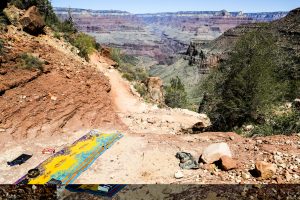 Work your way back into child’s pose to open and relax the body and mind. Take at least ten full yoga breaths there. Try to expand your lower belly against your thighs as you breathe. (For reference of poses, check out yogajournal.com)
Work your way back into child’s pose to open and relax the body and mind. Take at least ten full yoga breaths there. Try to expand your lower belly against your thighs as you breathe. (For reference of poses, check out yogajournal.com)
On an inhale, come into table pose, hands beneath the shoulders, knees beneath the hips, toes pointed, fingers spread, spine and neck parallel to the ground. Take a couple breaths then begin cat and cow tilts with your breath.
After cat and cow tilts, push up and back into your down dog. Really remember to push into the solid, ancient stone with your hands and feet, and pull your hips up to the sky. Take at least eight breaths there.
Then, step or walk into a forward bend. Spend a lot of time there, breathing and folding deeper, rocking forward and backward, side to side, gently, naturally, listening to the body and what areas might need your focus.
Roll up, vertebra by vertebra, into mountain pose. Spread your palms at your side and reach your arms out and over your head. Spread, spread widely and openly and powerfully, absorbing the canyon and its mass and the sun and its strength.
Embody that and pull your palms into your heart, into a small prayer pose. Duck your chin into your chest, countering that embodiment of power with a gesture of humility. This is practice is much more passive than powered, so begin to feel the patient essence of the water that has molded the rock here over eons.
| Small wildlife is common along the trail. | 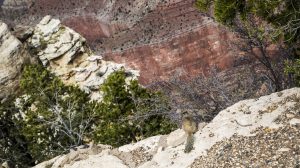 |
With the fluidity and passive strength of water, bring your hands back down, out, and over your head before swan diving back into your forward fold.
Take one breath to expand and reach through your head. On the exhale, fold back down and step or walk the feet back into a plank pose. Hold that for five breaths, eyes up on the unchanging scenery.
Come down slowly to the earth. Pushing into its solidity, come up into two cobra poses on consecutive inhales. On the third deep inhale, come all the way up into your upward facing dog. Open your heart to the sun and sky. Take five breaths there, then push back into down dog on an exhale.
Deepening into a Yin practice:
From here, slow down your practice into Yin poses. If you haven’t done Yin yoga before, it’s a practice much more about tranquility and patience than the cardio workouts of bikram or hatha yoga. Yin is about putting the body into positions that will open up muscles, joints, and fascia over a long stretch, usually a few minutes. The breath slowly opens up the pose and the reshapes the body like water has slowly opened up and reshaped the Canyon.
To start, take a deep inhale from down dog to press the right toe up and back towards the rim of the canyon. On the exhale, bring that foot forward and to the right, outside, of your right hand, into the center of the canyon.
Dragon pose. Push up onto your hands and lengthen from your hips on an inhale, then relax down towards the ground to your own degree. You’re going to hold this for 25 to 30 full breaths, so don’t rush it. If it feels to deep, back out and use the breath to go at it again.
After your last breath, extend your arms again to push yourself away from the ground. Heel-toe, heel-toe your right foot to the left side of your mat. Let your right knee fold out into pigeon pose. Draw 25 to 30 full breaths there for the right hip.
On an inhale, gently, very gently and slowly, come back up and lean right to swing your left leg around to the front.
Bring the right foot to the inside of the let leg for a one-legged forward fold. Draw another 25 to 30 breaths there. This is where the mental game comes to me sometimes where I become impatient and the stretches feel a little uncomfortable. If you breathe through the discomfort mindfully, patiently, and listen to your body, your legs will thank you on the hike up later.
After the bend, roll back up to seated. Bring your right knee in to your left knee, as close as they go comfortably. Bring your right foot by your butt, into half straddle pose. A deep breath there to lengthen. Then, relax back completely. Let your head and neck fall down your back. Relax your shoulders. Feel that knee heal through your 25 to 30 breaths.
On an inhale, push yourself back up into seated. The next pose is the King of Yin. With that left leg extended, bring the right foot on top of your left leg just above the knee. Then, fold your left foot in towards your right knee. It’s okay if your knees fly up in crazy angles because most people’s hips are really stiff in this pose. Try to keep your ankles parallel to the front of your mat though.
Inhale and extend, reach your arms up, then on the exhale fold. You can keep your arms by your side or pressing the ground in front of you if you need extra support. Double, seated pigeon pose. Trust yourself. Be patient with your hip.
Daily tension builds up in the neck, but deep stresses and tensions build up in the hips. This stress, along with the breathing and poses that have got you here, set the mind for healing too, so along with a huge physical release, this pose is also hugely cathartic. Listen to that too.
After your 25 to 30 breaths, push back up into seated and unfold your legs as gingerly as you need.
When ready, step back into down dog. In down dog, walk the feet and heels closer to the ground, feeling the difference in those legs after stretching one side.
On an inhale, press your left toes back, and swing them into dragon pose on the exhale. Repeat the rest of those stretches on this side.
After finishing that side, stay seated, and swing your legs wide (you may also want to pivot 90 degrees on your mat for more padding) into a straddle stretch. Inhale lengthen then stretch for 30 breaths there.
For the last stretch in this practice, swing back around and bring your feet together in front of your body for a simple, double-legged, seated forward fold. Hold that for 30 breaths as well.
With the legs so well stretched, it’s important we counterbalance the folding spine with an easy bend, so come into a prone position, then bring the elbows under the shoulders for sphinx pose. Relax there as long as you need and roll your neck around slowly to stretch it.
Finally, the best perspective of the Grand Canyon:
In your deeply peaceful state, bring your hands together and interlace your fingers in that sphinx pose, to make a nice cradle where you’ll put your head. Bring your knees under your hips and place the crown of your head into your hand-cradle, then walk your feet in so that your hips come over your head. Then, if you can, bring your legs off the ground, knees and toes into the torso, preparing for a headstand.
Push the feet the sky, and imagine yourself standing upside down with your feet pressing firmly into the sky, the air, the prana. Breathe deeply and smile. Do whatever modifications you want in headstand, scorpion, or whatever you want.
If you can’t get a headstand, maybe try tripod! If that’s not in your playbook yet either, at least give yourself a shoulder stand so that you have an inversion to open up the blood vessels of the legs.
Close the practice:
Come onto your back and bring your knees towards your belly. Grab them and roll them around, drawing shapes on the ground where your lower back makes contact. Find some natural, massaging motion. Then, slide your hands down the outside of your shins, but keep your arms inside your legs. Grab the outsides of your feet for…happy baby! Smile! Giggle. Let it out and find bliss. Roll side to side and maybe tip over like a turtle on its back.
Bring both the knees back in then, on an exhale, let them both fall over to the right while you spread your arms, long to the sides, and keep your shoulders on the ground. An easy twist.
After a few breaths, bring them back into center, and on the exhale, relax them to the left.
Last, corpse pose:
Finish the practice by hugging your knees into your belly and exhaling into savasana, corpse pose. Let your breath be slow and natural and relax the entire body into the red sandstone. Take your time here and don’t worry if you fall asleep.
After slowly coming out of corpse pose, roll as easily as you can into the fetal position and take a few breaths there to remember the simplicity of the pose, the essence. This is the pose your heart started beating in. The Hopi people were born here too. Feel time larger than yourself, and bathe in that. Use it to unburden you.
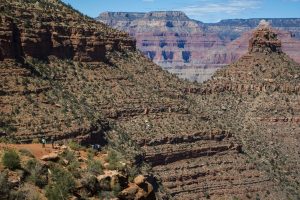 |
| Can you spot the hikers in this distant view from near the trail? |
Sit back up into a cross-legged seated pose. Bow and give thanks, “Namaste, I see you world, I thank you.” Thank yourself for taking time to repair your body and mind. Keep your eyes soft, and maybe let a gentle smile creep across. Your practice is complete.
You can continue your day down the canyon from here, or stay where you are and relax and read a book like I did. Either way, keep in mind that the place you visit is sacred, not by being a specific religion’s monument, but sacred in the way the ocean is sacred or the mountain is sacred.
The trails have been tread by centuries of people who had a reverence for this land, this site because something about it is so grand, so awe-inspiring, so moving, that it cuts past our everyday experience into something greater and more vital.

Comments are Closed